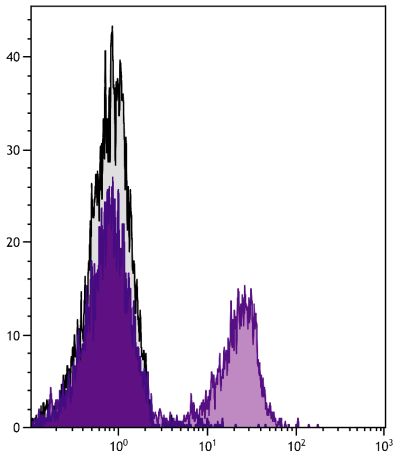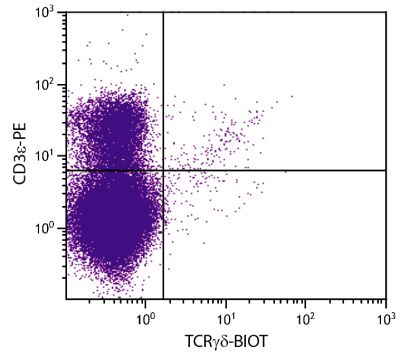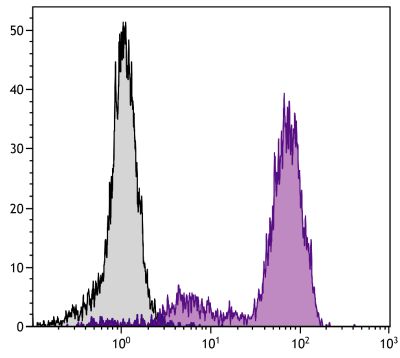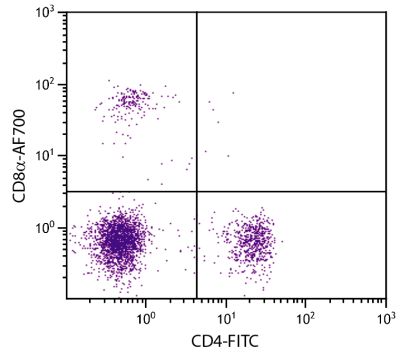Hamster Anti-Mouse TCRβ-APC (H57-597)
Cat. No.:
1785-11
APC Anti-Mouse TCRβ antibody for use in flow cytometry assays.
$206.00
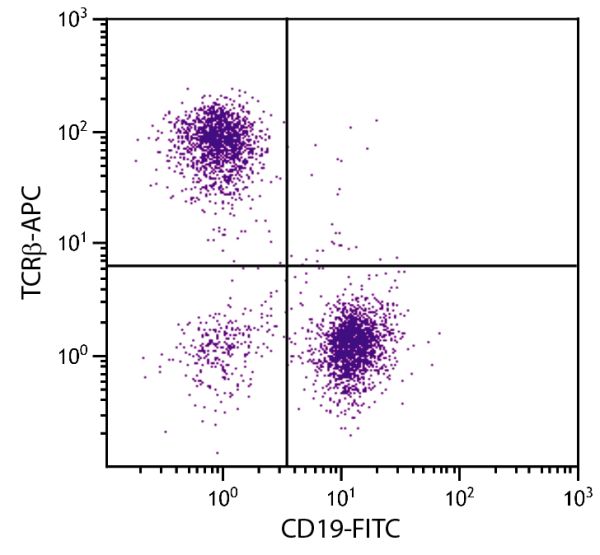

| Clone | H57-597 |
|---|---|
| Isotype | Hamster (Armenian) IgG2 |
| Isotype Control | Hamster IgG-APC |
| Specificity | Mouse TCRβ |
| Description | The αβ TCR is expressed on T lymphocytes of all mouse strains tested. The H57-597 monoclonal antibody does not react with γδ TCR-bearing cells. Plate-bound or soluble H57-597 activates αβ TCR-bearing T cells. In vitro and in vivo, H57-597 can induce immature thymocytes to undergo apoptosis. In vivo administration of H57-597 has been shown to deplete αβ TCR-bearing cells to near completion and prevent graft rejection. |
| Immunogen | TCR affinity purified from mouse T-cell hybridoma DO-11.10 |
| Conjugate | APC (Allophycocyanin) |
| Buffer Formulation | Phosphate buffered saline containing < 0.1% sodium azide and a stabilizer |
| Clonality | Monoclonal |
| Concentration | 0.1 mg/mL |
| Volume | 1.0 mL |
| Recommended Storage | 2-8°C; Avoid exposure to light; Do not freeze |
| Applications |
Flow Cytometry – Quality tested 1,8-12 Immunohistochemistry –Reported in literature 7 Immunocytochemistry – Reported in literature 6 Immunoprecipitation – Reported in literature 1 Stimulation – Reported in literature 1,2 Depletion – Reported in literature 3,4 Separation – Reported in literature 5 |
| RRID Number | AB_2795283 |
| Gene ID |
21577 (Mouse) |
| Gene ID Symbol |
Tcrb (Mouse) |
| Gene ID Aliases | TCRbeta; Tib |
Documentation
Certificate of Analysis Lookup
Enter the Catalog Number and Lot Number for the Certificate of Analysis you wish to view
- 1. Kubo RT, Born W, Kappler JW, Marrack P, Pigeon M. Characterization of a monoclonal antibody which detects all murine αβ T cell receptors. J Immunol. 1989;142:2736-42. (Immunogen, FC, IP, Stim)
- 2. Zerrahn K, Held W, Raulet DH. The MHC reactivity of the T cell repertoire prior to positive and negative selection. Cell. 1997;88:627-36. (Stim)
- 3. Davenport C, Kumar V, Bennett M. Rapid rejection of H2k and H2k/b bone marrow cell grafts by CD8+ T cells and NK cells in irradiated mice. J Immunol. 1995;155:3742-9. (Depletion)
- 4. Atsuta N, Nishimura H, Nakamura N, Emoto M, Iwatsuki T, Yoshokai Y. Diversity of Vγ gene segments rearranged to the Jγ4 gene in mice. J Immunol. 1995;154:676-84. (Depletion)
- 5. Lagrota-Candido J, Vasconcellos R, Cavalcanti M, Bozza M, Savino W, Quirico-Santos T. Resolution of skeletal muscle inflammation in mdx dystrophic mouse is accompanied by increased immunoglobulin and interferon-γ production. Int J Exp Path. 2002;83:121-32. (Sep)
- 6. Dong L, Watanabe K, Itoh M, Huan C, Tong X, Nakamura T, et al. CD4+ T-cell dysfunctions through the impaired lipid rafts ameliorate concanavalin A-induced hepatitis in sphingomyelin synthase 1-knockout mice. Int Immunol. 2012;24:327-37. (ICC)
- 7. Chatenoud L, Thervet E, Primo J, Bach J. Anti-CD3 antibody induces long-term remission of overt autoimmunity in nonobese diabetic mice. Proc Natl Acad Sci USA. 1994;91:123-7. (IHC)
- 8. Buslepp J, Kerry SE, Loftus D, Frelinger JA, Appella E, Collins EJ. High affinity xenoreactive TCR:MHC interaction recruits CD8 in absence of binding to MHC. J Immunol. 2003;170:373-83. (FC)
- 9. Galkina E, Tanousis K, Preece G, Tolaini M, Kioussis D, Florey O, et al. L-selectin shedding does not regulate constitutive T cell trafficking but controls the migration pathways of antigen-activated T lymphocytes. J Exp Med. 198;9:1323-35. (FC)
- 10. Rodríguez-Borlado L, Barber DF, Hernández C, Rodríguez-Marcos MA, Sánchez S, Hirsch E, et al. Phosphatidylinositol 3-kinase regulates the CD4/CD8 T cell differentiation ratio. J Immunol. 2003;170:4475-82. (FC)
- 11. Woolf E, Xiao C, Fainaru O, Lotem J, Rosen D, Negreanu V, et al. Runx3 and Runx1 are required for CD8 T cell development during thymopoiesis. Proc Natl Acad Sci USA. 2003;100:7731-6. (FC)
- 12. Conrad ML, Davis WC, Koop BF. TCR and CD3 antibody cross-reactivity in 44 species. Cytometry. 2007;71A:925-33. (FC, Porcupine Reactivity)
See All References


